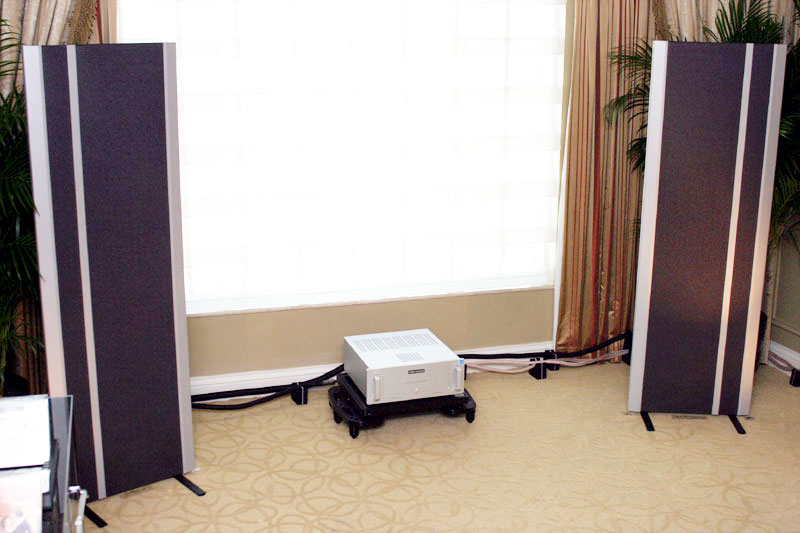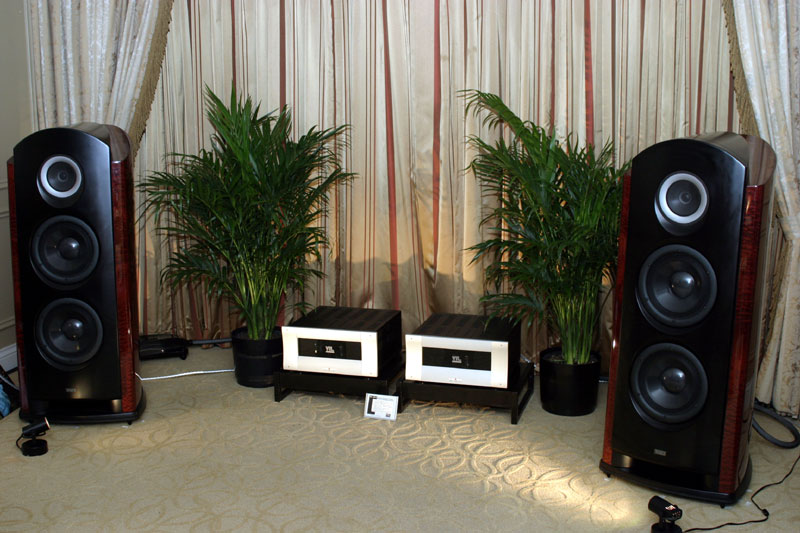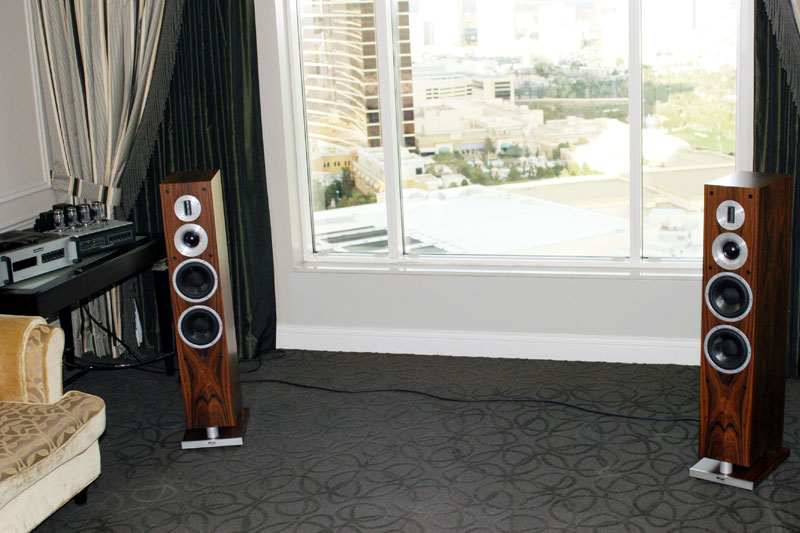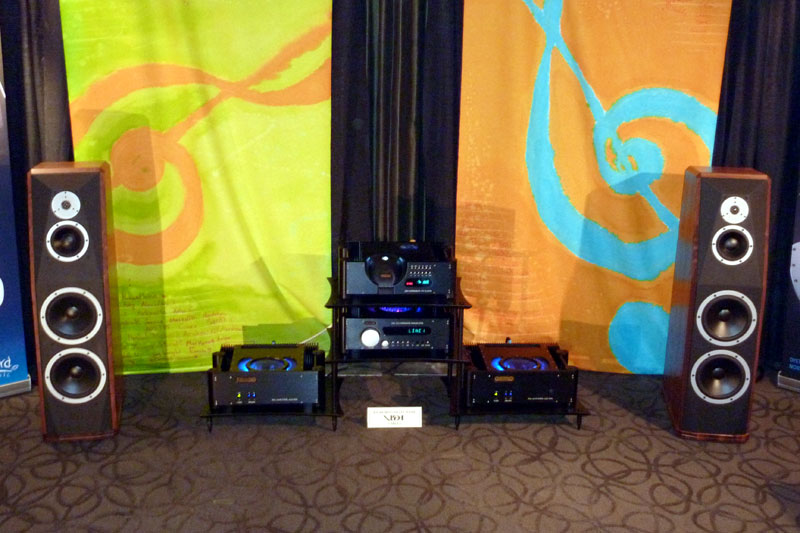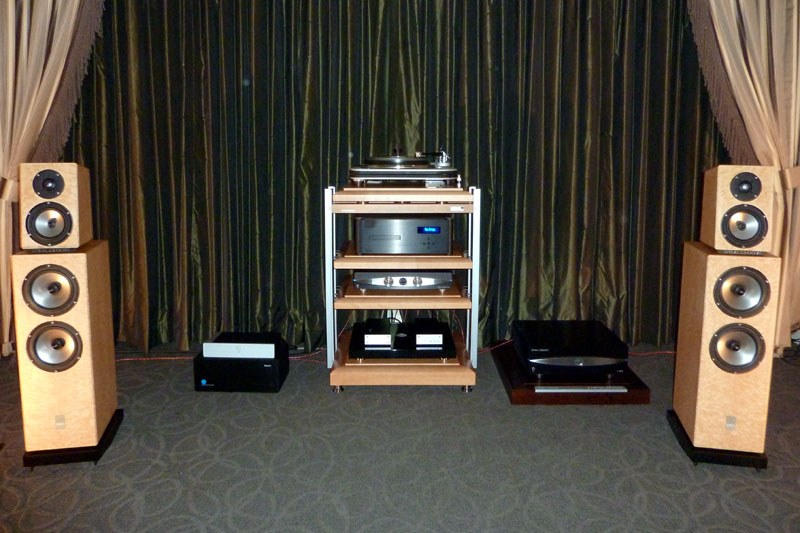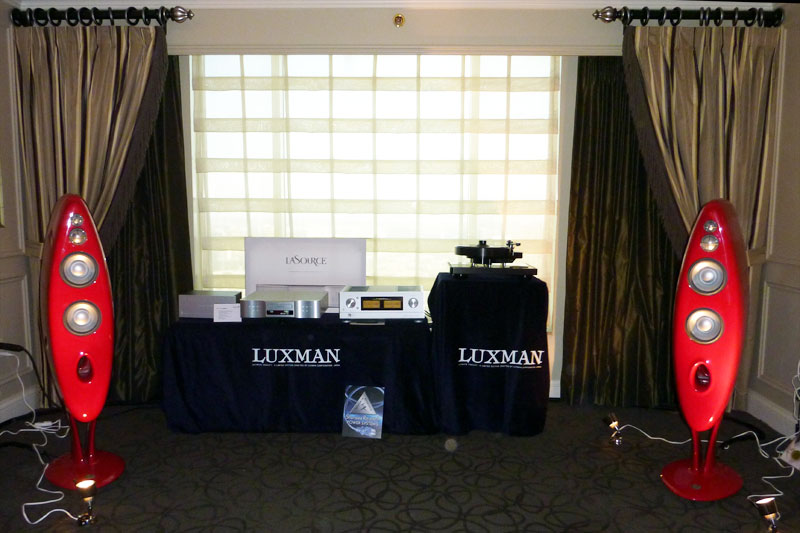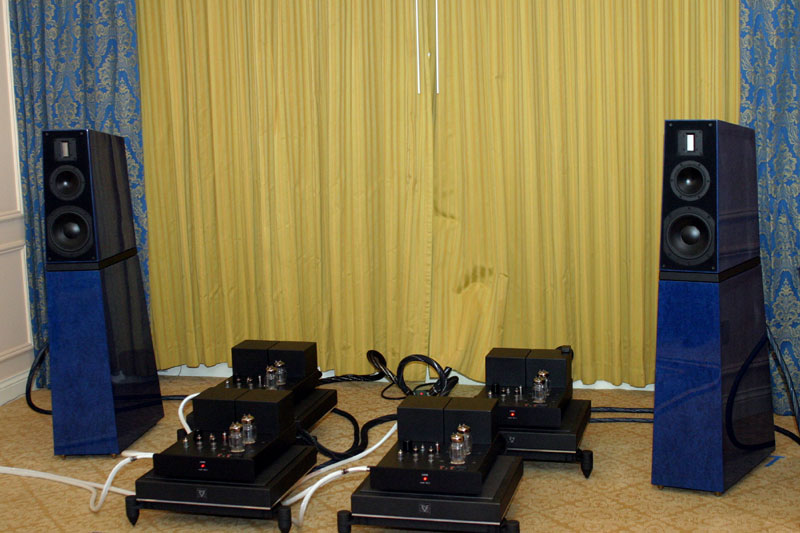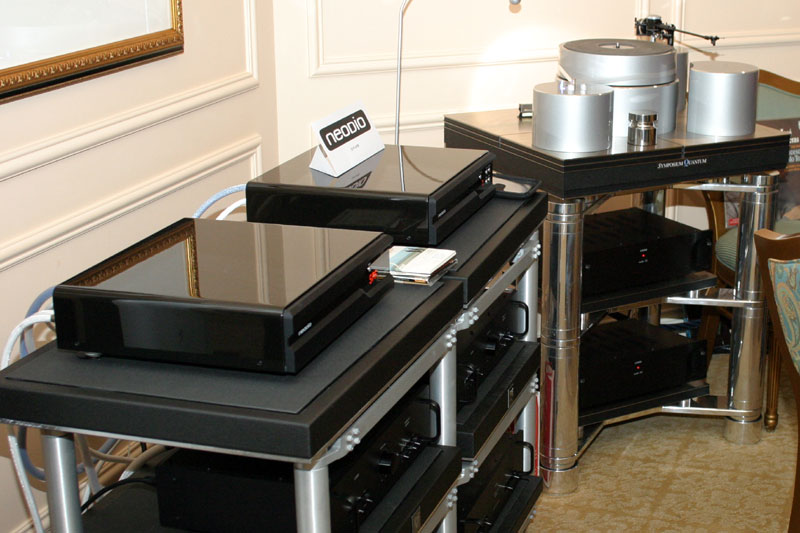CES & THE Show 2011 • Baubles, Bangles & Beads
At the 2010 CES, The Audio Beat was a new concern, having been online for a mere three months. This year, we were established, with a thriving website and a constantly expanding readership to show for a year of hard work. As usual, Marc Mickelson posted his coverage each day from Las Vegas, while I roamed the precincts to my heart’s content and experienced in nearly full measure the breadth and depth of the best the audio industry has to offer. In the words of Frank Sinatra, it was a very good year. The Balanced Audio Technology room held both the expected and the unexpected. The former was represented by the new version of BAT's flagship solid-state amplifier, the VK-655SE ($14,000, 300Wpc), which replaces the VK-600. The new amplifier features a thoroughly revised power supply with "second generation" oil-filled caps as used in the Rex preamplifier ($20,000) and a smartly updated industrial design. For the truly power mad, the ‘655SE can be configured as a mono amp. The remainder of the system consisted of a VPI Classic III 'table with matching JMW 'arm ($6000), a VK-P10SE phono stage with a SuperPak capacitor upgrade ($9500), the aforementioned Rex preamp and the very familiar (to me) Wilson Audio Sasha W/P speakers ($26,900/pair). The unexpected was a prototype from the upcoming BAT line of phono cartridges. These have been developed in collaboration with Soundsmith’s Peter Ledermann. There will eventually be two BAT cartridges: the P1 and P2 ($4800 and $6800, respectively). BAT’s Geoff Poor explained that they had given Ledermann what amounted to a blank check to take his already well-respected moving-iron designs to heretofore unheard-of levels of technical and sonic sophistication. Given what I heard, I can definitely say that the P2 tracked with exactly the surefootedness Ledermann and Poor claimed for it. Given my lengthy experience with the Wilson Sashas, I can confidently say that the BAT system was timbrally rich without being "romantic," highly resolving, and musically involving on all levels. I have been going to audio shows for the better part of fifteen years, and two of the enduring constants over that time have been VTL and Audio Research. I cannot recall hearing either of these tube stalwarts putting on a presentation that was less than noteworthy, and true excellence has been far more common than not. At the Venetian, both companies built on their stellar presentations from October’s Rocky Mountain Audio Festival.
Audio Research reprised its Reference Anniversary preamplifier ($24,995), Reference Phono 2 phono stage ($11,995), Reference CD8 CD player ($9995), DAC8 digital-to-analog converter ($4995) and added a DS450 power amp ($7995) to the mix. Spiral Groove supplied a top-line SG1.1 turntable ($25,000) and Centroid tonearm ($6000) carrying Lyra’s very impressive Kleos cartridge ($2750). Shunyata Research’s Hydra 8 and latest cabling were also on hand. The ARC components are all well known to me from various auditions and are all world class, with the Reference Anniversary setting a standard all its own. What made this system more than another predictably first-rate Audio Research setup, however, was the world premier of the long-awaited Magnepan 3.7 loudspeaker ($5495-$5995/pair depending on finish option). The new Maggies could not have been in better company, and it is a major understatement to say that this speaker is a completely new paradigm in terms of performance per dollar. The 3.7 is not "a good speaker for the money," it is a barrier-smashing component that laps the field of speakers costing less than $15,000/pair, provided one has a Magnepan-friendly (more or less rectangular and at least medium-sized) room. The 3.7, as noted by John Crossett in his blog on the subject, has real grip and power in the bass range, a midrange that is as natural and uncolored as any speaker's, and superbly integrated and effortless treble that extends well beyond the range of human hearing. It speaks with one voice from top to bottom and has remarkable dynamic slam for a planar speaker. This was the most auspicious loudspeaker debut I have heard in many a moon, and if the 3.7 is not a spectacular runaway success, I can’t imagine what would or could be.
VTL, a company on a serious roll these days, showed two complete systems. The "big" system consisted of the new-at-the-RMAF TL-7.5 Reference Series III preamplifier ($20,000) and MB-450 Signature Series III mono power amplifiers ($18,000/pair), the TP-6.5 phono stage ($7500), top-of-the-line Transparent wiring and TAD’s Reference One speakers ($65,000/pair). The "small" system featured the TL-5.5 Series II full-function preamp ($8000 including phono stage) and the brand-new MB-185 Signature Series II monoblocks ($14,500/pair, 300W pentode and 135W triode) and the always fine-sounding Avalon Indra speakers ($19,995/pair). Shared sources for the two systems were the same Spiral Groove/Lyra analog front-end that ARC used, and dCS’s Paganini transport ($16,999), master clock ($7999), DAC ($17,999), and upsampler ($10,499). Both systems were exceedingly pleasing with both my own tunes (Hiromi’s "Green Tea Farm" from her Brain CD [Telarc CD-63600] and Brian Auger & the Trinity with Julie Driscoll’s stupendous cover of "Light My Fire" from the excellent 24-bit remastered CD of 1970’s Steetnoise [Polydor 8433992] were my demo tracks of choice here and for much of the show) and the Beethoven Piano Concerto No.1 and Pink Martini LPs that Luke Manley and Bea Lam played. The always-impressive TAD speakers let the power and finesse of the big line stage and power amps shine, just as they did with the Wilson Sasha W/Ps in Denver.
The '450s’ new little sibling, the '185, is based on the '450 but reworked to make the most of the EL34 power tube. A well-made EL34 is one of the gold standards for high-end, hand-wired guitar amplifiers and has a delightful sweetness and delicacy that, backed by a traditionally stiff and overbuilt VTL power supply, yields nothing in the way of traction and oomph in the lower ranges. The '185-anchored system was immediately inviting, very much a "pour a glass of wine, put on some tunes and relax" system. I can’t imagine any real music lover not falling in love with the perfectly wonderful sound this system produced. Well done, VTL. (And, hey, Luke and Bea, I would love to review the new '7.5.)
ProAc’s energetic US distributor, Richard Gerberg, followed up last year’s debut of the Carbon Pro 6 speaker with the new Response K6 ($24,000/pair). Some $6000 less than its older brother, the K6 incorporates much of the same driver technology as the Carbon Pro 6 in a more conventional HDF cabinet that is internally damped with bitumen. The front-end was an Audio Research Reference CD8 CD player ($9995) and VSi60 integrated amplifier ($3995), the latter equipped with ARC’s new KT120 power tubes for increased output. Richard’s eclectic musical tastes (he encouraged me to play some electronic favorites) and genial high spirits always make the ProAc room a pleasurable stop, and the sound of the Response K6 only added to the fun. Marc Mickelson schlepped the show pair of K6s back to Arizona with him, and a review will be coming, so stay tuned.
Toronto’s Bluebird Music arrived with a powerful and well-balanced system consisting of Chord Electronics’ Red Reference Mk II CD player ($25,900), CPA 5000 preamp ($21,900) and SPM 1400 500W monoblocks ($32,900/pair), along with Peak Consult’s formidable El Diablo V speakers ($89,000/pair). All was tied together with van den Hul MC 3T Mountain interconnects ($3490/pair) and Nova loudspeaker cables ($3295/pair). I mentioned Avalon in tandem with the VTL room, but the Colorado company also had something up its sleeve in its own room. The Transcendent speaker ($14,995/pair) acquitted itself marvelously in a room bristling with treatments to tame the hotel acoustics. Music was provided by a Resolution Audio Cantata Music Center ($6000) augmented by a Grace Design M 903 USB DAC ($1895) for computer files, and Edge Electronics supplied a Signature preamp ($14,388) and an NL 12.2 stereo amplifier ($24,388, 300Wpc), which provided the motivating force. Cardas Clear cabling tied everything together in this intimate and enjoyable system. As usual, the articulation of Avalon speakers was superb. Nola once again brought the marvelous Baby Grand loudspeakers ($54,000/pair) with a full rig of Audio Research Reference components, wall-to-wall Nordost Odin cabling and Quantum power-conditioning boxes. Also on hand was a UHA-UQ analog tape deck to supplement the CDs. This speaker and its little brother, the Metro Grand, inevitably produce some of the most dependably fine sounds at shows, and CES was no exception. And it is always enjoyable to visit with Carl and Marilyn Marchisotto, who are exceedingly nice people.
Spiral Groove’s Allen Perkins had his SG1.1 turntables and Centroid tonearms all over the show (there were eight Spiral Groove ‘tables in various rooms throughout the Venetian) and, unsurprisingly, in his own room. There, this elegant LP spinner was paired with prototypes of a preamp and power amp designed by Perkins, which may or may not see production depending on how the economy proceeds over the next year or so. Speakers were Sonics by Joachim Gerhard Allegra 2.0s ($10,000/pair). I listened to a few jazz LPs, and the sound was highly appealing. One would certainly hope that Allen makes these sweet-sounding electronics a commercial reality. Last year Japan’s BAlabo and Germany’s Tidal squeezed the massive Tidal Sunray loudspeakers ($151,000/pair), BALabo’s hefty 500W BP1 monoblocks ($77,000/pair) and BC1 preamplifier ($60,000) into a way-too-small room and still managed to get terrific sound. This year BAlabo importer Fred Nadel had a room befitting the majestic Sunrays and added the forthcoming BAlabo BD1 DAC (approximately $37,500) to the mix. There is something quite remarkable about the BAlabo electronics -- they combine the sort of resolution I’ve heard only from great tubed electronics and the Halcro (whatever happened to them?) and Technical Brain solid-state amps, with a really delicious, natural timbral sweetness that is unique. Further investigation is warranted, I believe.
On a Higher Note’s Venetian room (there was another at the Mirage I did not get a chance to visit) showcased Audio Aero’s new La Fontaine CD/SACD player/digital control center ($25,000), the gorgeously retro Luxman L590A II integrated amplifier ($9500, 30Wpc pure class A) and Vivid Audio’s K-1 loudspeakers ($25,000/pair). Shunyata Research did the cable honors. The La Fontaine is a direct offshoot of the stunning La Source that was so impressive at the Rocky Mountain Audio Fest, slightly simplified but built to Audio Aero’s exacting standards. It combines full CD/SACD playback functions, a tubed analog preamplifier with fixed or variable output, and a full complement of analog and digital inputs, including USB. The very space-age-looking Vivid K-1 incorporates much of the same technology as the South African manufacturer’s flagship Giya models to excellent effect. The sound was suave and most ingratiating. Alan Yun of Silverline Audio is as ebullient and enthusiastic as anyone in the business. While Silverline has never been a high-volume manufacturer, Yun’s products have always spoken a remarkable degree of musical truth, often at attractive prices. This year Alan was showing the Grand Bolero ($35,000/pair), a good-sized full-range floorstander that embodies all of the things I have liked about Silverline speakers for nearly a decade. It uses Dynaudio drivers tweaked to Yun’s delight, including the Esotar II, one of my all-time-favorite dome tweeters. An inveterate tinkerer and inventor, Yun was using a preamp that he designed and built himself and a CD player he had modified so heavily that I couldn’t begin to determine its lineage. Pass Labs’ X250.5 power amplifier supplied the needed horsepower. Each and every time I have heard a pair of Silverline speakers -- and a number of years back I owned a pair of Sonata IIs -- I sit back, relax, and think about music rather than hi-fi, and the Grand Bolero carried on that tradition very nicely. It seems that Alan Yun simply cannot design a speaker that is not engaging. Nordost debuted a new family of cables, the Leif, consisting of the White Lightning, Purple Flash, Blue Heaven LS, and Red Dawn LS lines, more information about which can be seen in our News story. Nordost’s Lars Kristensen is also affiliated with Danish speaker manufacturer Raidho, whose C1.0 stand-mount speaker has been a superb-sounding mainstay of Nordost’s cable demos for some years. At CES, Lars was proud to present the Raidho S2 ($11,000/pair), a floorstanding version of the C1.0, used with Jeff Rowland Design Group’s Corus preamp ($12,800) and 625 stereo power amp ($13,500, 300Wpc). Burmester’s 061 CD player drove the new Jeff Rowland Aeris DAC ($9800), the long-established company’s first digital product. Obviously, Nordost cabling held pride of place. It really can not be said enough times, Jeff Rowland’s electronics are the most beautifully styled and finished in the business, at least to my eyes. Like the C1.0, the S2 produced a far larger and more authoritative sound than one might reasonably expect from such a modest enclosure, with the soundstage dimension, lucidity, speed and timbral refinement I have come to expect from the C1.0. It is eminently clear that Raidho’s Michael Boerreson is a designer of considerable talent. Wadia, now under the same corporate umbrella as Audio Research and Sonus Faber, came well armed with the 971 transport ($17,950), 931 controller/line stage and 922 mono Decoding Computers ($33,450 in toto), a QSonix 205 2TB/17 music-management system ($7950), Octave MRE 130 amps ($16,000/pair) and Dynaudio Confidence C2 speakers ($13,000/pair).
Lamm Industries debuted one of its very infrequent updated products: the new ML2.2 mono SET amplifiers ($37,190/pair, 18W each), a thoroughgoing revision of the legendary ML2.1. The new amps incorporate significant advances developed for the staggering ML3 Signature. The rest of the rather staggering system consisted of Redpoint’s XX turntable with custom rack ($75,000) carrying two Graham tonearms, the Phantom II ($4900) and Phantom II XL 12 ($5200), with Dynavector XV-1t cartridges ($9000 each), Lamm’s LL1 Signature line stage ($42,000), a pair of Lamm LP2 Deluxe phono preamps (one for each 'arm, $7590 each). NeoDio’s NR22T transport and NR22D DAC ($13,300 and $12,000 respectively) and Verity Lohengrin II speakers ($99,995/pair) driven by two pairs of the ML2.2s. Completing this amazing system were racking from Critical Mass Systems ($42,385 total) and cabling from Stealth Audio, including the Dream V10 speaker cables, Sakra interconnects and Dream power cables ($227,400 total).
Ryuichi Sakamoto’s live-with-orchestra version of "Forbidden Colours" from his Cinemage CD [Sony Music 60780] was breathtaking, with reverb trails that seemed to last forever, a creamy realism to David Sylvian’s emotive vocal and an enveloping sense of space and place. My notes on Hiromi’s "Green Tea Farm" were quite concise: "This just sings!" "Each Small Candle" from Roger Waters’ In the Flesh [Columbia 85235], a brilliantly recorded live CD, was overwhelming in the directness and completeness of its musical connection. As amazing as this system was -- and that is hard to
describe -- even more was waiting in the other Lamm room. |

